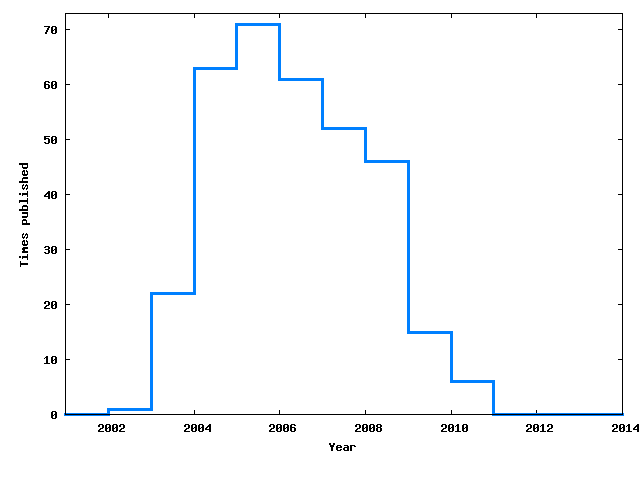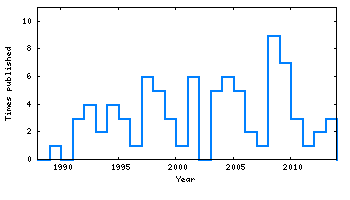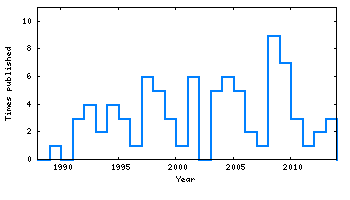A Physicist is an atom’s way of looking at itself.
Or the more believable: A Physicist is a physicist’s way of talking about himself.
I think Niels Bohr said that, atom’s way of looking at itself. Also sometimes credited to other folks in its closely-varying forms such as Kaku and Wald. But I don’t recall what exactly Feynman said. He also said something astounding of that sort regarding “atoms-and-us”.
( oh yea remember, I an atom in the universe an universe of atoms ?? )
But here is an evidence to all that. It just popped like a pop corn cos I was checking my inspire-HEP (what-a-name, I am inspired), Sean just posted that on f-b and I was checking mine and his particle-physics indices. His publication distributions are interesting, (look like rare-particle distributions) while mine is kind of typical of high statistics. (whats so typical, I wanna talk about)
Ok let me take the liberty of posting that here, he is a theoretical particle physicist and I am experimental so don’t look for correlations right away. Most of their work is individual or small group although applied to large groups and experiments (hence citations are correlated) but mine is experimental and as befitting to that you can’t see much personal impressions except the fact that we are hard-workers and we know our stuff and we like theoretical people, like all the time. One of the guys I talked the most when I was in KEK was Andrew, a theoretician. These people are uninhibited, experimentalists can be sort mentalists ( or sentimentalists?) although Yutaka Ushiroda was not at-all like that. He was very straight-forward at-times like me. (protons behave like electrons at time? Ask Michio Kaku, he seem to know it all).
But some experimentalists are big conversationalist though. Not hard to find if you are in one of those champagne get-together. Kazuo Abe, he was more like taunted by wife for drinkin all the time. (Abe san, sumi masen, gomen nasai, Mary san, gomen nasai)
Ok so we are diverting, but I am someone who likes to tell you everything and the threads are just freakishly entangled. SO one last thing Sean’s number of really famous papers quite high (and I have none, the one I missed to sign and another perhaps I did not care). SO here is his and mine.

So, Sean’s shows how for a theoretician’s career the papers must span as frequently as 4-10 in number every year for as large a time as 20 years, thats a lot of work, believe or not. You are producing 1 paper every 3 month to 1 paper every month, for last 20 years apart from books, journal review, conferences, world tours, teaching, research mentoring and what not. (and this is only Inspire-HEP, which came up a few years ago?)
But as I said I am not looking for correlations here, my aim in this article is purely pop-corn. It just pops and you would instantly grab it and eat it. It was about: atom’s way of looking at itself, and here a particle’s way of looking at itself. Boy thats so literal.
If you look at my distribution what you see is exactly what you would see in a momentum (or other variables) distribution for an elementary particle in a Particle Physics lab, and that caught my attention. This person’s publication distribution and an electron’s momenta distribution are just the same. A particle-physicist is a particle’s way of looking at itself.
Now let me explain therefore, till you get it.
What you are seeing are called frequency histograms, in the language of scientists/statisticians. What you are seeing plotted is a frequency of occurrence (Y-axis to grind) of some commodity (X-axis to grind). In a given bin how many times a variable occurs is whats called frequency. (the width of the rectangles are the X-of the bins and the frequency scaled in some ways usually gives the Y-of the variable, how many times a variable is occurring in a particular bin)
Here in both cases therefore the frequency (Y- or height or number) is the number of publications and the X- or width is a year’s time. For a particle’s case the X- would be say momenta and for a particular bin the momenta of that value. for example: an electron found 30 times in 0.6 – 0.7 MeV. 30 is the frequency, number of events. 0.6 – 0.7 (MeV) is the bin size in X, called as momentum bin and there would be 30 in this bin, 60 in another and so on. We would lets say plot from 0.2 MeV to 10 MeV and see that electrons events range from a threshold of 0.511 MeV to any higher value, with a pattern that resembles ones shown here. The momenta distribution of electrons would be exactly like the publications distributions of particle-physicists, the topic here, and why is that? (and it could be any particle, not just electron and not just momenta)
(And why is there a threshold for electron momenta? if scaled properly at a value of 0.511 MeV? That is why there would be no events below momenta of 0.511 MeV, and be careful that Momenta and energy are both MeV in c=1 units, which I have described in detail how to be read with caution: here; “A tip on speed-of-light-unit “. The threshold is at momenta =0.511 MeV because of energy conservation, the mass of electron is 0.511 MeV hence momentum must always be 0.511 or bigger)
But why is that, why the distribution of momenta of electron or any particle just like the publication distribution of a particle physicist?.
What the electrons are doing? Lets say there are 100 electrons in a system. These electrons are constantly interacting with other particles in the system constantly gaining or losing energy. SO when an electron in bin 0.6 – 0.7 MeV gained 0.2 MeV it will now appear in 0.8 – 0.9 MeV bin. On an average at any time there would be so many so many electrons that would be found in this bin and so and so many in that other bin and so on. These are characteristics depending on the kinematics of a given situation and the topography of whats involved. (eg if electrons are produced from a high-momenta K-meson then what its momenta value would range from, and so on and so forth)
What the electrons are doing? (the same as what the particle physicist is doing) The electron appears in the scene, gains momentum, goes up a bin, gains momentum, goes up a bin, gains further momentum, goes up a bin and so on, and at any time the numbers of electrons lying in a particular bin is slated like this, almost like a snap-shot. If you look closely, the electrons its easier for them to gain some momenta (or energy) from others or from their production, and they keep climbing to a bin which has most number of electrons but once they are there and they lose their momenta by certain process they are not as quick to lose that. They would (in groups of electrons as if jumping to a swimming pool in a group) lose their energy, but not too much. SO there is quick gaining of momenta or energy by bunch of electrons, but not quick losing of that energy, the rightwards is therefore tilting further and further rightwards while the left is steep.
Its akin to a car gaining speed quite fast, but to naturally bring it to rest it takes a lot longer than usual. You have certain inertia and thats not going to be lost, it will keep you at higher momenta, because inertia at higher momenta is higher, hence you prefer to keep to a state of higher momenta. When Sachin Tendulkar is at his peak, he will gradually perform better and better, than when he just started his game.
The same with particle-physicists, when they start their career, they perform less, then they build up their performance bigger and bigger till a peak, but lose that advantage slower than they gained. They gain faster and lose slower. There is no sharp down fall. A career in Physics if well built is not like Niagara falls. It will go down the ground and not via deep-space-fall. (if its good) Its not stock-market for Physicists how-much-ever they pretend.
So they start a publication into more and more height (and faster) then they can climb down (if there is no involvement eg, in my case with KEK) although slower, as-if climbing down a stair. (Climbing up can be through say an elevator and climbing down is through stairs, thats the best I can analogize on)
In my case therefore you see, 0 publications in 2001. The year I joined my PhD, I was learning more about snow-fall, JC Peney and Bus rides. 2002 I have hardly 1 or 2, that was the year when in the later half I was given the privilege of being able to sign for science papers. The next year I am already acquainted quite a bit, so signing more than 1 paper a month is no irksome involvement. I already know what I am signing it for. 20 papers a year. Then it grows to 60 papers the next year, thats 5 papers a month, my team of 400 was producing where I have a legit share of expert contributions, through weeks of data-collection, analysis and data-mining etc. (There would be papers where I won’t have legit share, .. ) The next year 2005-2006 was my peak, 70 papers, You can check my pictures from 05-06 (on f-b) and see how much I was involved in the literally tons of ways experimentalists contribute ;) No kidding not everything is visible outside the vacuum pipe, its risky)
The nature of scientific publications in Particle Physics Experiments. (My discussion in Epernicus — a science website — from 4 years ago )
Here is a word of detail before you see how to interpret the high-stat publication-distribution (such as mine) vs anything else in science-publication-distribution in general. How to make sense. The various details in various fields are different. eg in Satellite and Cosmology observational science the amount work and details of aspects would be quite different from say Microbiology research. Read an analysis I did at the top of my mind right after having my lunch and involving myself in an internet discussion regarding science publication facts, with some folks on an internet-forum for Science called Epernicus. That was 4.5 years ago, in July 2009, my early days of serious blogging perhaps, when I thought w/o such blogging my science involvements would be meaningless, as I have to tell the world what I have been doing for close to more than 8 years now. Click on the linked article.
Then you can see I am gradually climbing down, but its hard enough to climb down faster because you already have a history. Becoming celebrity is a one way affair, no return. With years my direct contribution goes down but history has that which is yet to come and that shows up as bigger share in contribution. (Just like the electron’s history-of-all-path must contribute towards its momenta for future)
I think thats a good connection, like the electrons the Physicists are lost, they are picking on different things and survive and their history makes it bigger.


Leave a comment